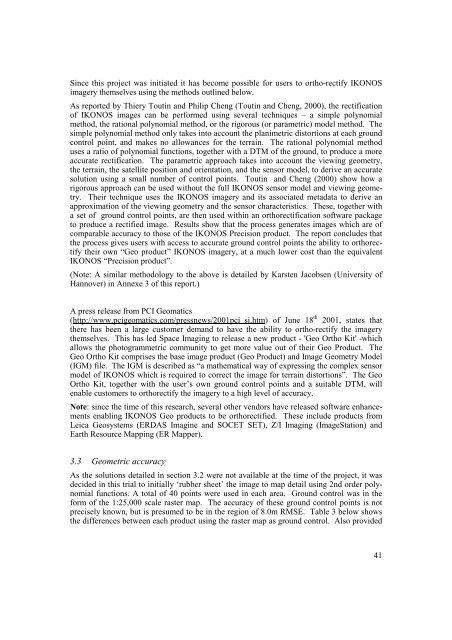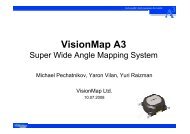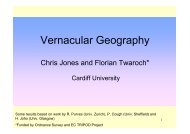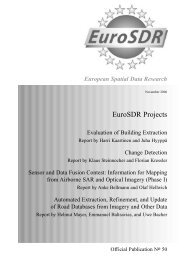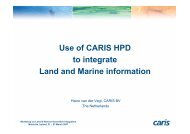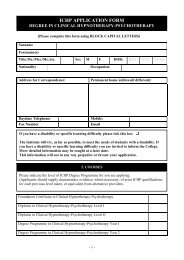European Organization for Experimental ... - Host Ireland
European Organization for Experimental ... - Host Ireland
European Organization for Experimental ... - Host Ireland
You also want an ePaper? Increase the reach of your titles
YUMPU automatically turns print PDFs into web optimized ePapers that Google loves.
Since this project was initiated it has become possible <strong>for</strong> users to ortho-rectify IKONOS<br />
imagery themselves using the methods outlined below.<br />
As reported by Thiery Toutin and Philip Cheng (Toutin and Cheng, 2000), the rectification<br />
of IKONOS images can be per<strong>for</strong>med using several techniques – a simple polynomial<br />
method, the rational polynomial method, or the rigorous (or parametric) model method. The<br />
simple polynomial method only takes into account the planimetric distortions at each ground<br />
control point, and makes no allowances <strong>for</strong> the terrain. The rational polynomial method<br />
uses a ratio of polynomial functions, together with a DTM of the ground, to produce a more<br />
accurate rectification. The parametric approach takes into account the viewing geometry,<br />
the terrain, the satellite position and orientation, and the sensor model, to derive an accurate<br />
solution using a small number of control points. Toutin and Cheng (2000) show how a<br />
rigorous approach can be used without the full IKONOS sensor model and viewing geometry.<br />
Their technique uses the IKONOS imagery and its associated metadata to derive an<br />
approximation of the viewing geometry and the sensor characteristics. These, together with<br />
a set of ground control points, are then used within an orthorectification software package<br />
to produce a rectified image. Results show that the process generates images which are of<br />
comparable accuracy to those of the IKONOS Precision product. The report concludes that<br />
the process gives users with access to accurate ground control points the ability to orthorectify<br />
their own “Geo product” IKONOS imagery, at a much lower cost than the equivalent<br />
IKONOS “Precision product”.<br />
(Note: A similar methodology to the above is detailed by Karsten Jacobsen (University of<br />
Hannover) in Annexe 3 of this report.)<br />
A press release from PCI Geomatics<br />
(http://www.pcigeomatics.com/pressnews/2001pci_si.htm) of June 18 th 2001, states that<br />
there has been a large customer demand to have the ability to ortho-rectify the imagery<br />
themselves. This has led Space Imaging to release a new product - 'Geo Ortho Kit' -which<br />
allows the photogrammetric community to get more value out of their Geo Product. The<br />
Geo Ortho Kit comprises the base image product (Geo Product) and Image Geometry Model<br />
(IGM) file. The IGM is described as “a mathematical way of expressing the complex sensor<br />
model of IKONOS which is required to correct the image <strong>for</strong> terrain distortions”. The Geo<br />
Ortho Kit, together with the user’s own ground control points and a suitable DTM, will<br />
enable customers to orthorectify the imagery to a high level of accuracy.<br />
Note: since the time of this research, several other vendors have released software enhancements<br />
enabling IKONOS Geo products to be orthorectified. These include products from<br />
Leica Geosystems (ERDAS Imagine and SOCET SET), Z/I Imaging (ImageStation) and<br />
Earth Resource Mapping (ER Mapper).<br />
3.3 Geometric accuracy<br />
As the solutions detailed in section 3.2 were not available at the time of the project, it was<br />
decided in this trial to initially ‘rubber sheet’ the image to map detail using 2nd order polynomial<br />
functions. A total of 40 points were used in each area. Ground control was in the<br />
<strong>for</strong>m of the 1:25,000 scale raster map. The accuracy of these ground control points is not<br />
precisely known, but is presumed to be in the region of 8.0m RMSE. Table 3 below shows<br />
the differences between each product using the raster map as ground control. Also provided<br />
41


